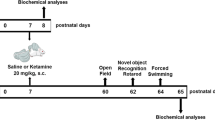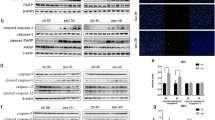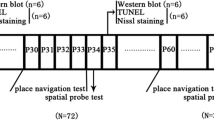Abstract
Neonatal exposure to general anesthetics has been associated with neurotoxicity and morphologic changes in the developing brain. Isoflurane is a volatile anesthetic widely used in pediatric patients to induce general anesthesia, analgesia, and perioperative sedation. In the present study, we investigated the effects of a single neonatal isoflurane (3% in oxygen, 2 h) exposure in rats at postnatal day (PND) 7, in short-term (24 h — PND8) and long-term (adulthood) protocols. In PND8, ex vivo analysis of hippocampal and frontal cortex slices evaluated cell viability and susceptibility to in vitro glutamate challenge. In adult rats, behavioral parameters related to anxiety-like behavior, short-term memory, and locomotor activity (PND60-62) and ex vivo analysis of cell viability, membrane permeability, glutamate uptake, and susceptibility to in vitro glutamate challenge in hippocampal and cortical slices from PND65. A single isoflurane (3%, 2 h) exposure at PND7 did not acutely alter cell viability in cortical and hippocampal slices of infant rats (PND8) per se and did not alter slice susceptibility to in vitro glutamate challenge. In rat’s adulthood, behavioral analysis revealed that the neonatal isoflurane exposure did not alter anxiety-like behavior and locomotor activity (open field and rotarod tests). However, isoflurane exposure impaired short-term memory evaluated in the novel object recognition task. Ex vivo analysis of brain slices showed isoflurane neonatal exposure selectively decreased cell viability and glutamate uptake in cortical slices, but it did not alter hippocampal slice viability or glutamate uptake (PND65). Isoflurane exposure did not alter in vitro glutamate-induced neurotoxicity to slices, and isoflurane exposure caused no significant long-term damage to cell membranes in hippocampal or cortical slices. These findings indicate that a single neonatal isoflurane exposure did not promote acute damage; however, it reduced cortical, but not hippocampal, slice viability and glutamate uptake in the adulthood. Additionally, behavioral analysis showed neonatal isoflurane exposure induces short-term recognition memory impairment, consolidating that neonatal exposure to volatile anesthetics may lead to behavioral impairment in the adulthood, although it may damage brain regions differentially.






Similar content being viewed by others
Disclaimer
The financial support agencies had no further role in study design; in the collection, analysis, and interpretation of data; in the writing of the report; and in the decision to submit the paper for publication.
Data Availability
All data generated or analysed during this study are included in this published article.
References
Abe H, Ishida Y, Iwasaki T (2004) Perirhinal N-methyl-D-aspartate and muscarinic systems participate in object recognition in rats. Neurosci Lett 356(3):191–194. https://doi.org/10.1016/j.neulet.2003.11.049
Baumgart JP, Zhou ZY, Hara M, Cook DC, Hoppa MB, Ryan TA, Hemmings HC Jr (2015) Isoflurane inhibits synaptic vesicle exocytosis through reduced Ca2+ influx, not Ca2+-exocytosis coupling. Proc Natl Acad Sci USA 112(38):11959–11964. https://doi.org/10.1073/pnas.1500525112
Brambrink AM, Evers AS, Avidan MS et al (2010) Isoflurane-induced neuroapoptosis in the neonatal rhesus macaque brain. Anesthesiology 112(4):834–841. https://doi.org/10.1097/ALN.0b013e3181d049cd
Briner A, De Roo M, Dayer A, Muller D, Habre W, Vutskits L (2010) Volatile anesthetics rapidly increase dendritic spine density in the rat medial prefrontal cortex during synaptogenesis. Anesthesiology 112(3):546–556. https://doi.org/10.1097/ALN.0b013e3181cd7942
Broadbent NJ, Gaskin S, Squire LR, Clark RE (2010) Object recognition memory and the rodent hippocampus. Learn Mem 17(1):5–11. https://doi.org/10.1101/lm.1650110
Coleman K, Robertson ND, Dissen GA et al (2017) Isoflurane anesthesia has long-term consequences on motor and behavioral development in infant rhesus macaques. Anesthesiology 126(1):74–84. https://doi.org/10.1097/ALN.0000000000001383
Creeley C, Dikranian K, Dissen G, Martin L, Olney J, Brambrink A (2013) Propofol-induced apoptosis of neurones and oligodendrocytes in fetal and neonatal rhesus macaque brain. Br J Anaesth 110(Suppl 1):i29-38. https://doi.org/10.1093/bja/aet173
Dal-Cim T, Ludka FK, Martins WC et al (2013) Guanosine controls inflammatory pathways to afford neuroprotection of hippocampal slices under oxygen and glucose deprivation conditions. J Neurochem 126(4):437–450. https://doi.org/10.1111/jnc.12324
Dal-Cim T, Poluceno GG, Lanznaster D, de Oliveira KA, Nedel CB, Tasca CI (2019) Guanosine prevents oxidative damage and glutamate uptake impairment induced by oxygen/glucose deprivation in cortical astrocyte cultures: involvement of A1 and A2A adenosine receptors and PI3K, MEK, and PKC pathways. Purinergic Signal 15(4):465–476. https://doi.org/10.1007/s11302-019-09679-w
Davidson AJ (2011) Anesthesia and neurotoxicity to the developing brain: the clinical relevance. Paediatr Anaesth 21(7):716–721. https://doi.org/10.1111/j.1460-9592.2010.03506.x
De Roo M, Klauser P, Briner A et al (2009) Anesthetics rapidly promote synaptogenesis during a critical period of brain development. PLoS ONE 4(9):e7043. https://doi.org/10.1371/journal.pone.0007043
Dumas TC (2005) Late postnatal maturation of excitatory synaptic transmission permits adult-like expression of hippocampal-dependent behaviors. Hippocampus 15(5):562–578. https://doi.org/10.1002/hipo.20077
Eckenhoff JE (1953) Relationship of anesthesia to postoperative personality changes in children. AMA Am J Dis Child 86(5):587–591. https://doi.org/10.1001/archpedi.1953.02050080600004
Frink EJ Jr, Malan TP, Atlas M, Dominguez LM, DiNardo JA, Brown BR Jr (1992) Clinical comparison of sevoflurane and isoflurane in healthy patients. Anesth Analg 74(2):241–245. https://doi.org/10.1213/00000539-199202000-00012
Futterer CD, Maurer MH, Schmitt A, Feldmann RE Jr, Kuschinsky W, Waschke KF (2004) Alterations in rat brain proteins after desflurane anesthesia. Anesthesiology 100(2):302–308. https://doi.org/10.1097/00000542-200402000-00019
Ganzberg S (2017) The FDA warning on anesthesia drugs. Anesth Prog 64(2):57–58. https://doi.org/10.2344/0003-3006-64.2.57
Garcia PS, Kolesky SE, Jenkins A (2010) General anesthetic actions on GABA(A) receptors. Curr Neuropharmacol 8(1):2–9. https://doi.org/10.2174/157015910790909502
Gupta A, Datta PK (2020) Sevoflurane consumption during inhalational induction in children: a randomized comparison of minute ventilation-based techniques with standard fixed fresh gas flow technique. AANA J 88(3):177–182
Hestrin S (1992) Developmental regulation of NMDA receptor-mediated synaptic currents at a central synapse. Nature 357(6380):686–689. https://doi.org/10.1038/357686a0
Hogan K (2004) Long-lasting changes in brain protein expression after exposure to an anesthetic. Anesthesiology 100(2):209–212. https://doi.org/10.1097/00000542-200402000-00003
Jiang C, Wan X, Jankovic J et al (2004) Dopaminergic properties and experimental anti-parkinsonian effects of IPX750 in rodent models of Parkinson disease. Clin Neuropharmacol 27(2):63–73. https://doi.org/10.1097/00002826-200403000-00004
Kim GH, Lee JJ, Lee SH, Chung YH, Cho HS, Kim JA, Kim MK (2016) Exposure of isoflurane-treated cells to hyperoxia decreases cell viability and activates the mitochondrial apoptotic pathway. Brain Res 1636:13–20. https://doi.org/10.1016/j.brainres.2016.01.052
Liu J, Wang P, Zhang X, Zhang W, Gu G (2014) Effects of different concentration and duration time of isoflurane on acute and long-term neurocognitive function of young adult C57BL/6 mouse. Int J Clin Exp Pathol 7(9):5828–5836
Lowry OH, Rosebrough NJ, Farr AL, Randall RJ (1951) Protein measurement with the Folin phenol reagent. J Biol Chem 193(1):265–275
Ludka FK, Dal-Cim T, Binder LB, Constantino LC, Massari C, Tasca CI (2017) Atorvastatin and fluoxetine prevent oxidative stress and mitochondrial dysfunction evoked by glutamate toxicity in hippocampal slices. Mol Neurobiol 54(5):3149–3161. https://doi.org/10.1007/s12035-016-9882-6
Lueptow LM (2017) Novel object recognition test for the investigation of learning and memory in mice. J Vis Exp (126). https://doi.org/10.3791/55718
McCann ME, Soriano SG (2019) Does general anesthesia affect neurodevelopment in infants and children? BMJ 367:l6459. https://doi.org/10.1136/bmj.l6459
Molz S, Decker H, Dal-Cim T, Cremonez C, Cordova FM, Leal RB, Tasca CI (2008) Glutamate-induced toxicity in hippocampal slices involves apoptotic features and p38 MAPK signaling. Neurochem Res 33(1):27–36. https://doi.org/10.1007/s11064-007-9402-1
Molz S, Dal-Cim T, Tasca CI (2009) Guanosine-5’-monophosphate induces cell death in rat hippocampal slices via ionotropic glutamate receptors activation and glutamate uptake inhibition. Neurochem Int 55(7):703–709. https://doi.org/10.1016/j.neuint.2009.06.015
Molz S, Dal-Cim T, Budni J et al (2011) Neuroprotective effect of guanosine against glutamate-induced cell death in rat hippocampal slices is mediated by the phosphatidylinositol-3 kinase/Akt/ glycogen synthase kinase 3beta pathway activation and inducible nitric oxide synthase inhibition. J Neurosci Res 89(9):1400–1408. https://doi.org/10.1002/jnr.22681
Mosmann T (1983) Rapid colorimetric assay for cellular growth and survival: application to proliferation and cytotoxicity assays. J Immunol Methods 65(1–2):55–63. https://doi.org/10.1016/0022-1759(83)90303-4
Murphy KL, Baxter MG (2013) Long-term effects of neonatal single or multiple isoflurane exposures on spatial memory in rats. Front Neurol 4:87. https://doi.org/10.3389/fneur.2013.00087
National Research Council (2011) Guide for the Care and Use of Laboratory Animals: Eighth Edition. Washington, DC: The National Academies Press. https://doi.org/10.17226/12910
Neudecker V, Perez-Zoghbi JF, Coleman K et al (2021) Infant isoflurane exposure affects social behaviours, but does not impair specific cognitive domains in juvenile non-human primates. Br J Anaesth 126(2):486–499. https://doi.org/10.1016/j.bja.2020.10.015
Noguchi KK, Johnson SA, Dissen GA et al (2017) Isoflurane exposure for three hours triggers apoptotic cell death in neonatal macaque brain. Br J Anaesth 119(3):524–531. https://doi.org/10.1093/bja/aex123
Orliaguet G, Vivien B, Langeron O, Bouhemad B, Coriat P, Riou B (2001) Minimum alveolar concentration of volatile anesthetics in rats during postnatal maturation. Anesthesiology 95(3):734–739. https://doi.org/10.1097/00000542-200109000-00028
Palanisamy A, Crosby G, Culley DJ (2017) Early gestational exposure to isoflurane causes persistent cell loss in the dentate gyrus of adult male rats. Behav Brain Funct 13(1):14. https://doi.org/10.1186/s12993-017-0132-5
Patel P, Sun L (2009) Update on neonatal anesthetic neurotoxicity: insight into molecular mechanisms and relevance to humans. Anesthesiology 110(4):703–708. https://doi.org/10.1097/ALN.0b013e31819c42a4
Piermartiri TC, Vandresen-Filho S, de Araujo HB et al (2009) Atorvastatin prevents hippocampal cell death due to quinolinic acid-induced seizures in mice by increasing Akt phosphorylation and glutamate uptake. Neurotox Res 16(2):106–115. https://doi.org/10.1007/s12640-009-9057-6
Qu X, Xu C, Wang H et al (2013) Hippocampal glutamate level and glutamate aspartate transporter (GLAST) are up-regulated in senior rat associated with isoflurane-induced spatial learning/memory impairment. Neurochem Res 38(1):59–73. https://doi.org/10.1007/s11064-012-0889-8
Robinson MB, Jackson JG (2016) Astroglial glutamate transporters coordinate excitatory signaling and brain energetics. Neurochem Int 98:56–71. https://doi.org/10.1016/j.neuint.2016.03.014
Rosenholm M, Paro E, Antila H, Voikar V, Rantamaki T (2017) Repeated brief isoflurane anesthesia during early postnatal development produces negligible changes on adult behavior in male mice. PLoS ONE 12(4):e0175258. https://doi.org/10.1371/journal.pone.0175258
Sampaio TB, de Oliveira LF, Constantino LC et al (2018) Long-term neurobehavioral consequences of a single ketamine neonatal exposure in rats: effects on cellular viability and glutamate transport in frontal cortex and hippocampus. Neurotox Res 34(3):649–659. https://doi.org/10.1007/s12640-018-9927-x
Schaefer ML, Perez PJ, Wang M et al (2020) Neonatal isoflurane anesthesia or disruption of postsynaptic density-95 protein interactions change dendritic spine densities and cognitive function in juvenile mice. Anesthesiology 133(4):812–823. https://doi.org/10.1097/ALN.0000000000003482
Shen X, Liu Y, Xu S, Zhao Q, Guo X, Shen R, Wang F (2013) Early life exposure to sevoflurane impairs adulthood spatial memory in the rat. Neurotoxicology 39:45–56. https://doi.org/10.1016/j.neuro.2013.08.007
Stratmann G, Sall JW, May LD et al (2009a) Isoflurane differentially affects neurogenesis and long-term neurocognitive function in 60-day-old and 7-day-old rats. Anesthesiology 110(4):834–848. https://doi.org/10.1097/ALN.0b013e31819c463d
Stratmann G, May LD, Sall JW et al (2009b) Effect of hypercarbia and isoflurane on brain cell death and neurocognitive dysfunction in 7-day-old rats. Anesthesiology 110(4):849–861. https://doi.org/10.1097/ALN.0b013e31819c7140
Stratmann G, Sall JW, May LD, Loepke AW, Lee MT (2010) Beyond anesthetic properties: the effects of isoflurane on brain cell death, neurogenesis, and long-term neurocognitive function. Anesth Analg 110(2):431–437. https://doi.org/10.1213/ANE.0b013e3181af8015
Tsukamoto A, Konishi Y, Kawakami T, Koibuchi C, Sato R, Kanai E, Inomata T (2017) Pharmacological properties of various anesthetic protocols in 10-day-old neonatal rats. Exp Anim 66(4):397–404. https://doi.org/10.1538/expanim.17-0037
Walsh RN, Cummins RA (1976) The open-field test: a critical review. Psychol Bull 83(3):482–504
Wang X, Shan Y, Tang Z, Gao L, Liu H (2019) Neuroprotective effects of dexmedetomidine against isoflurane-induced neuronal injury via glutamate regulation in neonatal rats. Drug Des Dev Ther 13:153–160
Wang HY, Eguchi K, Yamashita T, Takahashi T (2020) Frequency-dependent block of excitatory neurotransmission by isoflurane via dual presynaptic mechanisms. J Neurosci 40(21):4103–4115. https://doi.org/10.1523/JNEUROSCI.2946-19.2020
Yuan T, Bellone C (2013) Glutamatergic receptors at developing synapses: the role of GluN3A-containing NMDA receptors and GluA2-lacking AMPA receptors. Eur J Pharmacol 719(1–3):107–111. https://doi.org/10.1016/j.ejphar.2013.04.056
Zhang G, Dong Y, Zhang B et al (2008) Isoflurane-induced caspase-3 activation is dependent on cytosolic calcium and can be attenuated by memantine. J Neurosci 28(17):4551–4560. https://doi.org/10.1523/JNEUROSCI.5694-07.2008
Zhao T, Li C, Wei W, Zhang H, Ma D, Song X, Zhou L (2016) Prenatal ketamine exposure causes abnormal development of prefrontal cortex in rat. Sci Rep 6:26865. https://doi.org/10.1038/srep26865
Zou X, Sadovova N, Patterson TA et al (2008) The effects of L-carnitine on the combination of, inhalation anesthetic-induced developmental, neuronal apoptosis in the rat frontal cortex. Neuroscience 151(4):1053–1065. https://doi.org/10.1016/j.neuroscience.2007.12.013
Zuo Z (2001) Isoflurane enhances glutamate uptake via glutamate transporters in rat glial cells. NeuroReport 12(5):1077–1080. https://doi.org/10.1097/00001756-200104170-00042
Funding
This research was supported by grants from Brazilian funding agencies: Conselho Nacional de Desenvolvimento Científico e Tecnológico (CNPq) — Instituto Nacional de Ciência e Tecnologia (INCT for Excitotoxicity and Neuroprotection); Coordenação de Aperfeiçoamento de Pessoal de Nível Superior (CAPES/PVE 052/2012; CAPES-FCT 2014), Fundação de Apoio à Pesquisa do Estado de Santa Catarina (FAPESC)—Programa de Apoio aos Núcleos de Excelência (PRONEX — Project NENASC); and by Portuguese funding agencies: Fundação para a Ciência e Tecnologia (FCT, Portugal) — (Strategic Project 2015-UID/NEU/04539/2013); COMPETE-FEDER (POCI-01–0145-FEDER-007400); Centro 2020 Regional Operational Programmes (CENTRO-01–0145-FEDER-000012: HealthyAging2020 and CENTRO-01–0145-FEDER-000008: BrainHealth 2020). C.I.T. and R.D.P. are recipient of research fellowship from CNPq.
Author information
Authors and Affiliations
Contributions
Conceptualization and design of the study: C.I. Tasca, L.F. de Oliveira, R.D. Prediger and F.C. Pereira; material preparation and methodology: L.F. de Oliveira, G.G. Poluceno, T.B. Sampaio, L.C. Constantino, A.P. Costa, W.C. Martins, T. Dal-Cim, K.A. Oliveira, F.K. Ludka; formal analysis and investigation: L.F. de Oliveira, G.G. Poluceno, T.B. Sampaio, L.C. Constantino, A.P. Costa, W.C. Martins, T. Dal-Cim, K.A. Oliveira, F.K. Ludka; writing — original draft preparation: G.G. Poluceno and T.B. Sampaio; writing — review and editing: C.I. Tasca, L.C. Constantino, T. B. Sampaio and F.C. Pereira; funding acquisition: C.I. Tasca, R.D. Prediger and F.C. Pereira; Supervision: C.I. Tasca and F.C. Pereira.
Corresponding authors
Ethics declarations
Ethics Approval
Experiments followed the “Principles of Laboratory Animal Care” (NIH 2011) and were approved by the Committee on the Ethics of Animal Experiments of the Federal University of Santa Catarina (CEUA/UFSC PP955).
Conflict of Interest
The authors declare no competing interests.
Additional information
Publisher's Note
Springer Nature remains neutral with regard to jurisdictional claims in published maps and institutional affiliations.
Ana Paula Costa´s current affiliation: Brain Health Imaging Institute, Department of Radiology, Weill Cornell Medicine, New York, NY, USA.
Rights and permissions
Springer Nature or its licensor (e.g. a society or other partner) holds exclusive rights to this article under a publishing agreement with the author(s) or other rightsholder(s); author self-archiving of the accepted manuscript version of this article is solely governed by the terms of such publishing agreement and applicable law.
About this article
Cite this article
de Oliveira, L.F., Poluceno, G.G., Sampaio, T.B. et al. Neonatal Isoflurane Exposure in Rats Impairs Short-Term Memory, Cell Viability, and Glutamate Uptake in Slices of the Frontal Cerebral Cortex, But Not the Hippocampus, in Adulthood. Neurotox Res 40, 1924–1936 (2022). https://doi.org/10.1007/s12640-022-00607-2
Received:
Revised:
Accepted:
Published:
Issue Date:
DOI: https://doi.org/10.1007/s12640-022-00607-2




